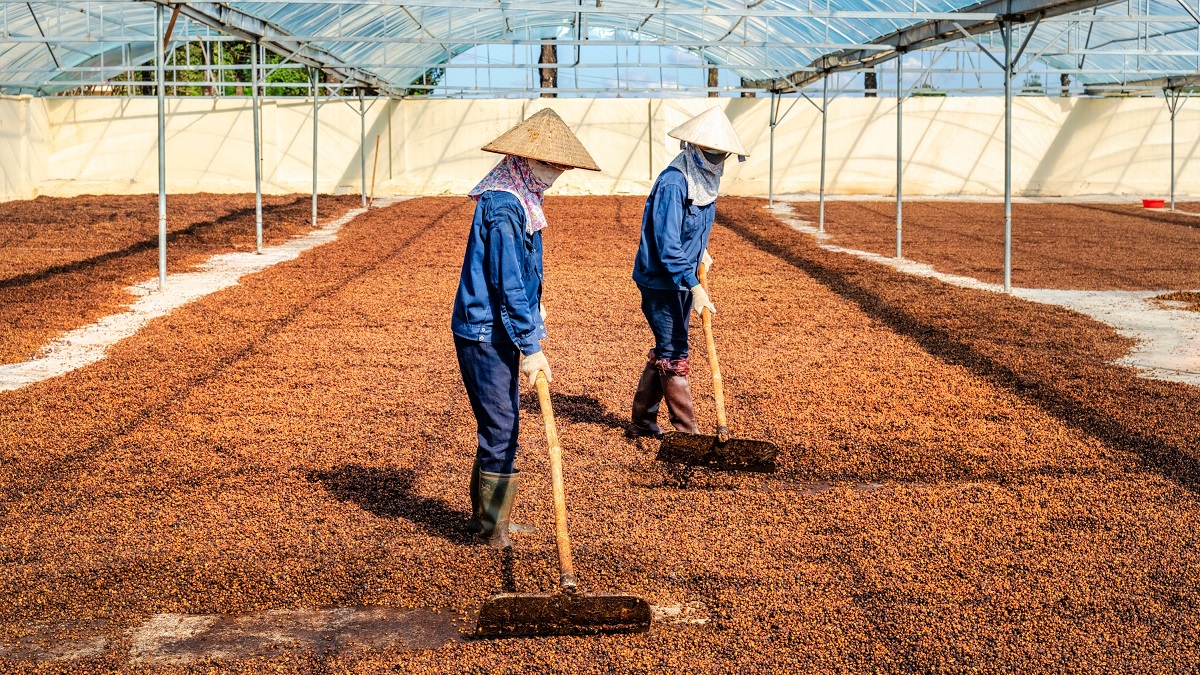The annual handbook provides key data and indicators on how the economy has evolved across regions, countries and sectors.

© Shutterstock/Nguyen Quang Ngoc Tonkin | Workers dry coffee beans in Gia Lai, Viet Nam.
UNCTAD released on 14 December its Handbook of Statistics 2023 – the global reference for trade and development trends published each year.
It provides official statistics on how the global economy has evolved across regions, countries and sectors. An online version allows people to interact with the data, charts and graphs.
By using “nowcasts”, the handbook provides data-driven real-time estimates of current developments. These can assist governments in anticipating shifts in trade and the economy before final official statistics are available.
“Timely and quality data are critical now more than ever in an era of multiple global crises,” says Anu Peltola, head of UNCTAD Statistics. “These statistics will help countries take evidence-based decisions to tackle today’s challenges rather than yesterday’s.”
Below are some of the key trends for 2022 and 2023 highlighted in the report.
International trade dynamics
- Trade in goods falls: Following a strong recovery from COVID-19 in 2021, goods exports increased by 11.4% in 2022, reaching $29 trillion. But statistics show a 4.6% decrease in merchandise trade in the first half of 2023, and UNCTAD nowcasts a continued year-on-year decline for the third and fourth quarters.
- Trade in services continues to rise: Trade in services rebounded by 14.8% in 2022, surpassing pre-pandemic levels. Services trade grew more in developing countries, which in 2022 reached their highest global market share to date at 30%. Globally, UNCTAD nowcasts around 7% growth for trade in services in 2023.
- Global trade imbalances increase: Developed economies recorded a growing merchandise trade deficit, reaching $1.6 trillion in 2022.
- Commodity exports increase: All major commodity groups saw significant trade increases in 2022. Fuel exports grew by nearly 62% due to higher prices. Food exports grew by 10%.
Commentary: Recent statistics indicate a shift in the world’s recovery from the pandemic, marked by a decrease in the value of goods traded and a leveling off in the growth of trade in services. Trade in services took much longer than goods to return to pre-pandemic levels, which contributed to trade deficits in countries heavily reliant on services exports.
Regional trends
- Regional integration differences remain: For Europe and Asia, more than half of exports remain within the region, whereas for Oceania, Africa and the Americas, most of their exports are directed to other regions.
- South-South trade increases: The value of trade between developing countries grew by 13%. But developing economies still trade more with developed economies ($8.9 trillion) than among themselves ($6.1 trillion).
- Trade composition differs across regions: Africa’s exports are mainly primary goods (79% in 2022), while Asia and Oceania export mostly manufactured products (72% in 2022).
Commentary: Looking beyond averages, trade statistics show substantial differences across countries and reflect regional patterns. A high share of primary goods may indicate the need for a country to diversify its economy or strengthen its productive capacities to produce and trade goods and services with higher added value.
Global economic trends
- GDP growth slows: UNCTAD nowcasts a slowdown in global GDP growth from 3.1% in 2022 to 2.2% in 2023.
- Reduction of global economic inequality stalls: Over the past 10 years, the global distribution of GDP among economies has trended towards becoming more equal. However, the richest economies in the world accounted for 63% of global GDP in 2022 but only 17% of the world’s population. This presents a slight increase of inequality from 2021.
- Foreign direct investment falls: Global FDI fell by 12.4% in 2022, mainly due to a sharp 36.7% decline in developed economies. Meanwhile, FDI inflows grew by 4% in developing economies.
- Inflation returns from peak levels: Global inflation peaked in 2022, reaching its highest point in the 21st century. From early 2023, consumer prices started to return from their peak. For instance, global market fuel prices were 43% lower in August 2023 compared to their peak in August 2022, and food prices were 7% lower.
Commentary: Income disparities between countries remain high, with developed economies accounting for almost two thirds of global economic output but only one sixth of the world’s population. While inflation is gradually decreasing from the 2022 peak levels, the high cost of living still places strain on household finances globally.
Population and urbanization
- Population grows: The world’s population surpassed 8 billion in 2022, with most of the growth happening in Africa and developing economies in Asia. In 2022, five in six people lived in a developing economy.
- Old-age dependency increases: The share of elderly people is growing in all regions. This is causing total dependency ratios to increase everywhere except in Africa, where it’s expected to continue to decline beyond 2050 due to decreasing child dependency ratios.
- World becomes more urban: In 2022, 57% of the global population lived in urban areas.
Commentary: With five out of six people living in developing countries, their capacity to ensure environmental sustainability and good living conditions will be key to global efforts for inclusive and sustainable development. The world’s growing urban population underlines the need to focus on solutions for sustainable cities. Africa is the only region heading towards a period of a lower dependency ratio, which is seen as a demographic condition for fast economic growth.



